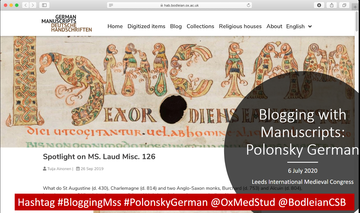Reaching out with medieval manuscripts
What do you get when you put together an excited group of medieval manuscript specialists and ask them to discuss blogging and teaching with digitized manuscripts? The answer: trumpets, drapes, marginal animal appearances, fake back-drops, cries of agony, laughter and lots of good advice.
A worldwide audience (from California to New Zealand!) gathered in three online sessions that were organized as additional evening events for the International Medieval Congress (IMC) at Leeds, 6–9 July 2020. The organisers were very pleased to see that each session had well over 100 participants. Our speakers shared their experiences on using digitized medieval manuscripts for teaching, and for reaching out to various audiences via social media, mainly through blogging and tweeting.
Blogging manuscripts with #PolonskyGerman
Tuija Ainonen, Andrew Dunning and Henrike Lähnemann (all of University of Oxford) opened the sessions by discussing their experiences on blogging for Manuscripts from German-Speaking Lands - A Polonsky Foundation Digitization Project. The project is in the middle of a three-year collaboration between the Bodleian Libraries in Oxford and the Herzog August Bibliothek in Wolfenbüttel. Funded by The Polonsky Foundation, the project seeks to open up the medieval German manuscript collections of two world-class libraries for research and reuse. The two libraries will digitize c. 600 medieval manuscripts of Germanic origin between 2019 and 2021.
https://www.youtube.com/embed/t7_Xcsn19UA
Watch to hear some thoughts on writing project based blogs on a variety of topics.
In the first session each presenter highlighted a blog post they had written. By opening up their writing processes they provided some useful tips for what to do, and what they would do differently. Even with specialized projects the aim is to write to non-specialists, so using approachable language and sentence structures is essential. As illustrative images are taken from digitized copies, it is crucial to provide readers with the manuscript shelfmark, folio reference and a link to the digital copy. It is important to follow the libraries’ attribution and guidance for terms of use that are provided in the meta-data of the images. However, the best place of the shelfmark is perhaps not on the title of the blog post.
Teaching the digital codex
In our second session Mary Boyle (University of Oxford), Julia Walworth (Merton College, Oxford) and Leonor Zozoya-Montes (University of Las Palmas de Gran Canaria) continued the theme of manuscript outreach. Discussions considered teachable features and pedagogical approaches to teaching with digital codices. Teaching the Codex was launched at Merton College, Oxford with a colloquium in February 2016, and it has since published formidable blogs on teachable features and links to paleographical and codicological training resources.
Listen to great insights into how to approach teaching the digital codex.
Their individual and collective insights provided the listeners with lots of new ideas and thoughts. Perhaps the not-so-pretty manuscripts also deserve more time in the limelight provided by blogs. Various teachable features and manuscripts that cover multiple texts provide fertile ground for highlighting medieval manuscripts from various different viewpoints.
Blogging manuscripts for the general public
In our final session Alison Hudson (University of Central Florida) and Alison Ray (Canterbury Cathedral Archives) took us through a whirlwind of images and advice on good social media practices as they showed us examples of their twitter and blog behaviour.
An excellent brief introduction to successful tweeting and blogging practices with medieval manuscripts
With a handy and useful group of guidelines for continuing our journey on blogging and tweeting with medieval manuscripts, one particular thought is worth repeating here. We as manuscript researchers and readers are in the best position to showcase and promote the work we do. Blogs provide us a handy way of showing ways in which medieval books are still relevant today, and how the old authors, compilers, scribes and readers of old continue to speak to current audiences.
Blog writing challenge
In preparing for these three sessions we encouraged our readers to submit blog proposals for potential future blog posts in the participating platforms. A good initial crop of intriguing proposals were discussed during the sessions, and we anticipate to publish several of them in the coming months. While the initial deadline of proposals was to ensure inclusion in our sessions, it is still not too late!
Manuscripts from German-Speaking Lands - A Polonsky Foundation Digitization Project continues to accept proposals showcasing to a general readership manuscripts digitized within the project. From 257 manuscripts (and counting!) to choose from, which one would you highlight and why? Proposals for blogs should be sent in the first instance to Andrew Dunning (andrew.dunning@bodleian.ox.ac.uk) or Matthew Holford (matthew.holford@bodleian.ox.ac.uk). Blogs of 500-750 words submitted by 22 August will be eligible for the Polonsky German blogging challenge. A panel will select the most successful blogs and will award prizes at the Dark Archives Conference 8-10 September 2020.
The Blogging with Manuscripts sessions were organised in collaboration with Manuscripts from German-Speaking Lands – A Polonsky Foundation Digitization Project, Oxford Medieval Studies, Teaching the Codex, and Dark Archives.
Follow us on Twitter: #PolonskyGerman, #BloggingMSS
For more medieval matters from Oxford, have a look at the website of the Oxford Medieval Studies TORCH Programme and the OMS blog!



